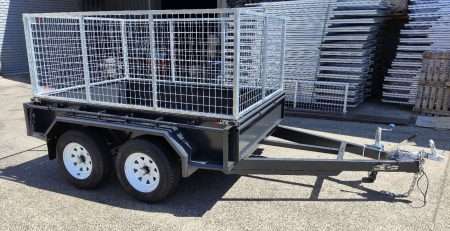
Unleashing the Power: The Ultimate Guide to Tow Hooks
Understanding Tow Hooks
In the realm of automotive exterior accessories, tow hooks play a vital role in ensuring vehicle safety and functionality, particularly in off-road conditions.
Defining Tow Hooks
Tow hooks are specialised pieces of equipment designed to enable easy extraction of vehicles that may have become stuck or non-drivable in certain situations. They are typically made of robust materials such as steel or aluminium, which can withstand the forces involved in towing and recovery operations.
These hooks are often an essential accessory for trucks, SUVs, and other vehicles designed to handle off-road conditions. They also play a crucial role in motorsports, facilitating the rapid removal of race cars that may have been involved in accidents on the track, thereby ensuring the safety of other participants.
Types of Tow Hooks
There are primarily two types of tow hooks, namely front tow hooks and rear tow hooks. As their names suggest, front tow hooks are typically mounted on the front bumper or frame of a vehicle, while rear tow hooks are secured to the rear bumper or frame.
The type of tow hook required largely depends on the vehicle’s use and the conditions in which it is likely to operate. For instance, off-road vehicles often benefit from having both front and rear tow hooks, providing more flexibility during recovery operations.
To comprehend the broader context of towing equipment, consider exploring other essential components such as the trailer brake controller, hitch receiver, or electric winch.
In the upcoming sections, we will delve into more details about tow hook specifications, their applications, legal requirements, and how to choose the right tow hook for your vehicle.
Tow Hook Specifications
When shopping for tow hooks, it is crucial to understand their specifications. These include the breaking strength capacity and dimensions of the hook. These factors will determine the tow hook’s compatibility with your vehicle and its suitability for your specific needs.
Breaking Strength Capacity
The breaking strength capacity is a critical specification of tow hooks. It refers to the maximum force that the hook can withstand before it breaks or fails. For example, a tow hook from Ratchet Straps USA boasts a 10,000-pound breaking strength capacity.
However, the required breaking strength can vary depending on where the tow hook is located on the vehicle. According to the New Jersey State Police’s Towing Regulations, the front tow hook or equivalent device must have a minimum breaking strength of 10,000 pounds, while the rear tow hook should have a minimum breaking strength of 15,000 pounds. Both should be attached to the vehicle’s structural frame or an equivalent structural member.
| Tow Hook Position | Minimum Breaking Strength |
|---|---|
| Front | 10,000 lbs |
| Rear | 15,000 lbs |
Tow Hook Dimensions
The dimensions of the tow hook, specifically the inside diameter opening, are another vital specification. The tow hook from Ratchet Straps USA has a 3/4-inch inside diameter opening. These dimensions will determine the types of straps or chains that can be used with the hook.
It’s important to ensure the tow hook’s dimensions are compatible with your vehicle and the equipment you plan to use. For instance, if you’re using an electric winch, you’ll need to ensure the tow hook can accommodate the winch cable.
Before purchasing a tow hook, always check the breaking strength capacity and dimensions to ensure it meets your needs. Remember, using a tow hook that is not suitable for your vehicle or task can lead to equipment failure, vehicle damage, and potential safety hazards.
Tow-Hook Applications
Tow hooks serve multiple purposes across a range of automotive applications. Their primary function is to provide a secure and reliable point of attachment for towing operations. In this section, we’ll delve into three critical applications of tow hooks: vehicle recovery, off-roading, and racing requirements.
Vehicle Recovery
Tow hooks play a vital role in the recovery of vehicles that have become stuck in elements such as mud, deep water, snow, or sand. They provide a sturdy anchor point that can be connected to a trailer winch or electric winch to exert the necessary pulling force for recovery. This makes them an essential tool for all vehicle owners, especially those who frequently drive in challenging terrain or weather conditions.
Off-Roading
Off-road enthusiasts and adventurers often find tow hooks indispensable. These hooks are an essential piece of equipment for off-road vehicles, allowing them to be easily pulled out if they get stuck. Tow hooks are considered an essential accessory for trucks and SUVs that go off-road and are also commonly seen on classic JDM vehicles. Their presence ensures the vehicle can be safely and efficiently recovered in the event of a breakdown or if the vehicle gets stuck.
Racing Requirements
In the world of automotive racing, safety is paramount. Tow hooks contribute to this aspect by providing a means to quickly remove non-drivable vehicles from the track after an accident, ensuring the safety of the driver and other participants. Tow hooks are recommended and sometimes required equipment in many racing series. Some performance-oriented vehicles even come equipped with tow hooks from the factory, highlighting their importance in this high-speed, high-risk sport.
As you can see, tow hooks serve essential roles in various automotive applications. Understanding these uses can help you better appreciate the importance of this simple yet critical piece of hardware in ensuring vehicle safety and efficiency.
Legal Requirements for Tow Hooks
When it comes to the use of tow hooks, it’s not just about selecting the right type of hook for your vehicle or the situation at hand. There are also legal requirements that must be met. These regulations vary by state and are in place to ensure the safety of all road users.
State-Specific Regulations
In some states like New Jersey, specific regulations govern the use of tow hooks. For instance, all registered and non-registered tow trucks in New Jersey must be equipped with a front and rear mounted tow hook or an equivalent device that meets the minimum requirements specified by the statute.
The front tow hook or equivalent device must have a minimum breaking strength of 10,000 pounds and must be attached to the vehicle’s structural frame or an equivalent structural member. On the other hand, the rear tow hook or equivalent device must have a minimum breaking strength of 15,000 pounds and must be attached in the same manner (Source).
If a tow truck is equipped with both a front and rear tow hook, they must be mounted a minimum of 20 inches apart or as specified by the vehicle manufacturer.
Penalties for Non-Compliance
Failure to comply with these regulations can lead to serious consequences. The use of tow hooks that do not meet the minimum breaking strength requirements or are not properly attached to the vehicle’s structural frame may result in a fine or other penalties from law enforcement.
It’s crucial for vehicle owners to be aware of and adhere to these regulations. In addition to understanding the legal requirements for tow hooks, it’s also important to know how to properly use and maintain your towing equipment. For more information on other towing products and accessories such as the electric winch, trailer brake controller, or hitch receiver, visit our other articles on these topics.
Choosing the Right Tow Hook
When it comes to selecting tow hooks for your vehicle, there are a variety of factors to consider. Two of the most important aspects to think about are the material of the tow hook and whether it’s vehicle-specific or universal.
Material Considerations
Tow hooks need to withstand significant forces during towing and recovery operations. As such, they’re typically made from strong materials like steel or aluminum. When choosing a tow hook, it’s crucial to look for products that promise quality in terms of both materials used and workmanship. There are proven US brands that offer reliable towing equipment, ensuring your tow hooks can withstand the demands of towing.
Vehicle-Specific vs Universal Hooks
There are two main types of aftermarket tow hooks available: vehicle-specific and universal. Vehicle-specific tow hooks are designed to perfectly fit a specific make, model, and year of vehicle. These hooks provide a tailored fit, ensuring optimal performance and safety. On the other hand, universal tow hooks are designed to work with a range of vehicles, often requiring minor modifications for fitment.
Vehicle-specific tow hooks can offer a more secure fit and efficient performance, but their application is limited to certain vehicles. In contrast, universal tow hooks offer flexibility in terms of application but may require additional time and effort to install correctly.
When choosing between vehicle-specific and universal tow hooks, consider your vehicle, towing needs, and comfort with potential modifications. Also, remember to follow manufacturer’s specifications and any applicable regulations for mounting tow hooks. Specific screw grips and a torque wrench should be used for tightening, ensuring the tow hook is safely and securely attached to the vehicle.
Whether you’re looking for vehicle-specific or universal tow hooks, it’s essential to choose a product that matches your vehicle and towing needs. Always prioritize safety and quality, and consider consulting a professional if you’re unsure about proper installation. For other towing equipment and accessories, check out our range of products like the trailer brake controller, trailer hitch lock, and electric winch.
Installation of Tow Hooks
Once you’ve chosen your tow hooks, it’s essential to install them correctly. Incorrectly placed tow hooks can lead to vehicle damage and unsafe towing situations.
Proper Attachment Points
When installing tow hooks, it’s critical to ensure they are securely mounted to the vehicle’s frame or structural components able to handle the load.
According to regulations, the front tow hook or equivalent device must have a minimum breaking strength of 10,000 pounds and must be attached to the vehicle’s structural frame or an equivalent structural member. In contrast, the rear tow hook or equivalent device must have a minimum breaking strength of 15,000 pounds and also be attached to a structural frame component.
If a tow truck is equipped with both a front and rear tow hook, they must be mounted a minimum of 20 inches apart or as specified by the vehicle manufacturer. This ensures that the load is distributed evenly, reducing the risk of structural damage.
Professional Installation Guidance
While it may be tempting to install tow hooks yourself, it is recommended to consult the vehicle’s owner’s manual or a professional mechanic for guidance on proper installation. This is important as the mounting points can vary depending on the make and model of your vehicle, and improper installation can lead to serious problems down the line.
A professional installer can ensure that the tow hooks are securely attached to the correct points on your vehicle’s frame and that they are installed at the correct angle for safe and effective towing. They can also guide you in maintaining your tow hooks and other towing equipment such as hitch receivers, trailer wiring harnesses and trailer winches.
Proper installation of tow hooks is an essential step in preparing your vehicle for towing. By ensuring that your tow hooks are correctly installed and securely mounted, you can confidently and safely tow loads with your vehicle.
Maintenance and Safety
Maintaining the condition of your tow hooks is critical for ensuring safe towing operations. This involves regular inspections and replacing any damaged hooks promptly.
Regular Inspections
Tow hooks should be inspected regularly for any signs of damage or wear. This includes checking for any cracks, bends, or rust on the hook, as well as ensuring that the hook is securely attached to the vehicle. Any signs of potential weakness could compromise the hook’s strength and lead to a failure during towing operations.
Regular inspections of your towing equipment can help you identify any issues early, allowing you to address them before they become a bigger problem. This not only ensures the safety of your towing operations but also extends the lifespan of your tow hooks.
Replacing Damaged Hooks
If your inspections reveal any damage or wear on your tow hooks, it is important to replace them immediately. Continuing to use a damaged hook can be dangerous, as it may fail under strain and lead to an accident.
When replacing your tow hooks, it’s crucial to choose high-quality replacements. Tow hooks are typically made of strong materials such as steel or aluminum to withstand the forces involved in towing and recovery operations. Therefore, it’s important to rely on the quality of the material, workmanship, and genuine products when selecting new tow hooks (tow-hooks.com).
In addition to tow hooks, it’s also important to regularly inspect and maintain the rest of your towing equipment, including your trailer brake controller, hitch receiver, and trailer light kit. By doing so, you can ensure the safety and efficiency of your towing operations.
Remember, safety should always be your top priority when towing. By conducting regular inspections and promptly replacing any damaged hooks, you can continue to tow with confidence.
Author
I am Rahatul Ashiq Tamal. Another author of Muscle Trailers. Muscle Trailers is a well-known trailer brand in Sydney, Melbourne & Adelaide

How to Mount a Spare Tire on Your Trailer: A Simple Step-by-Step Guide
Trailer service centers receive over 1 million phone calls and 1.3 million emails each year about trailer maintenance problems....

How to Fix RV Roof Leaks: Simple Roof Leak Detection Guide for Beginners
Did you know DIY RV roof repairs can cost under $50? But undetected leaks could lead to substantially higher repair...

Starting a Food Truck Business in Australia: From Trailer Selection to Launch
The Australian mobile food market has evolved into a billion-dollar industry. This makes a food truck...
